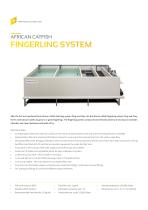
Catalog excerpts

PLUG-AND-PLAY HATCHERY SYSTEMS for the production of African catfish and Tilapia fingerlings
Open the catalog to page 1
AQUACULTURE ID SHORT HISTORY Aquaculture ID is a branch of Fleuren & Nooijen BV. The latter started in 1986 with a small hatchery for African catfish and has developed into a company designing and constructing aquaculture systems for a wide range of species. Using its extensive fish farming experience and knowledge, Fleuren & Nooijen is now a market leader helping people achieve their aqu aculture goals. Fleuren & Nooijen previously worked with both commercial fish farmers as well as academic researchers from universities and institutes. Both customer groups still do maintain fish in our...
Open the catalog to page 2
HATCHERY REQUIREMENTS We believe four requirements are essential for a successful hatchery: 1. RAS Technology. A Recirculating Aquaculture System is ideal for controlling the water parameters. With such equipment, your young fish are given optimal living conditions ensuring the best chance of healthy fingerlings. Good genetics. Using broodstock from a well-performing genetic strain improves the growth and health performance of your fish. Please contact us for prices and availability of our Dutch strain African catfish broodstock and/or Dutch strain African catfish fingerlings. High-quality...
Open the catalog to page 3
AFRICAN CATFISH PRODUCTION SCHEME Plug-and-Play hatchery systems are designed according to the different life stages of African catfish. Each life stage having certain requirements, these needs are the basis of the diverse systems’ designs.
Open the catalog to page 4
AFRICAN CATFISH The African catfish broodstock system Plug-and-Play allows full control of your African catfish broodstock and contributes to the good health of your fish. The combination of perfect husbandry and high quality broodstock fish feed, gives the best chances of having African catfish broodstock being in excellent condition. If desired, Aquaculture ID can also supply broodstock fish (Dutch strain African catfish) worldwide. SPECIFICATIONS: • 2x Polypropylene fish tanks with two outlets; one for return to sedimentation tank and one for draining the tank completely • 2x Cover (out...
Open the catalog to page 5
AFRICAN CATFISH ISOLATION SYSTEM In the African catfish isolation system Plug-and-Play, space available for up to three African catfish broodstock. These broodstock will be selected from the African catfish broodstock system and kept isolated prior to breeding. After breeding, the broodstock fish should be placed back in the isolation system to recuperate. SPECIFICATIONS: • 2x Polypropylene fish tanks Connection for freshwater supply Frame (out of SS304) with adjustable stands for easy system installation. PVC piping and fittings to connect the different system elements. Effective fish tank...
Open the catalog to page 6
AFRICAN CATFISH In the African catfish hatching system, the fertilised eggs, obtained from the selected broodstock, will be placed and hatched. Each floating egg tray, one in each tank, should be stocked with 100 grams of fertilised eggs. This will result in a total stocking density of 400 eggs per cycle. The fertilised eggs are then evenly spread over the sieves of the floating egg trays and hatch in around 24 hours (when water temperature is around 29 degrees Celsius). The larvae will fall through the mesh of the egg trays while the non-hatched eggs will stay behind. Treating the eggs...
Open the catalog to page 7
AFRICAN CATFISH FINGERLING SYSTEM After the fish are transferred from African catfish hatching system Plug-and-Play into the African catfish fingerling system Plug-and-Play, the fry need about 3 weeks to grow to 1-gram fingerlings. The fingerling system consists of two fish tanks which are very easy to maintain (disinfect and clean) between each batch of fry. SPECIFICATIONS: • 2x Polypropylene fish tanks with two outlets; one for return to sedimentation tank and one for draining the tank completely Sedimentation filter tank (mechanical filtration) allows for removing all the solid particles...
Open the catalog to page 8
AFRICAN CATFISH JUVENILE SYSTEM After the fish are transferred from African catfish fingerling system Plug-and-Play to the African catfish juvenile system Plug-and-Play, the fingerlings need about 4 weeks to grow to 5-gram juveniles. The juvenile system consists of two fish tanks which are very easy to maintain (disinfect and clean) between each batch of fry. These larger African catfish juveniles are much stronger than the smaller African catfish fingerlings, giving them a head start in the pre on-growing section of your African catfish grow out farm. SPECIFICATIONS: • 2x Polypropylene...
Open the catalog to page 9
Artemia or brine shrimp are used as a first feed for African catfish fry. The benefit of this fish feed is that it can be hatched on-site using cysts. These cysts have a very long shelf life (when stored vacuum and in the refrigerator many years) without losing hatching capacity. With our artemia hatching systems, you will be able to produce large quantities of artemia for your fry. SPECIFICATIONS: • 2x Polyethylene funnels (113 litres) with bottom outlet including ball valve • Frame (out of SS304) with adjustable stands for easy installation of system. • 1 TL-pendant 2x 36 Watt (240 V) •...
Open the catalog to page 10
HATCHING SYSTEM LARGE Artemia or brine shrimp are used as first feed for African catfish fry. The benefit of this fish feed is that it can be hatched on-site using cysts. These cysts have a very long shelf life (when stored vacuum and in the refrigerator many years) without losing hatching capacity. With our artemia hatching systems, you will be able to produce large quantities of artemia for your fry. SPECIFICATIONS: • 4x Polyethylene funnels (113 litres) with bottom outlet including ball valve Frame (out of SS304) with adjustable stands for easy system installation. Connection for...
Open the catalog to page 11
PRODUCTION SCHEME The Plug-and-Play hatchery systems are designed according to the different life stages of the tilapia. Each life stage having certain requirements. These requirements are the basis of the system’s design.
Open the catalog to page 12
